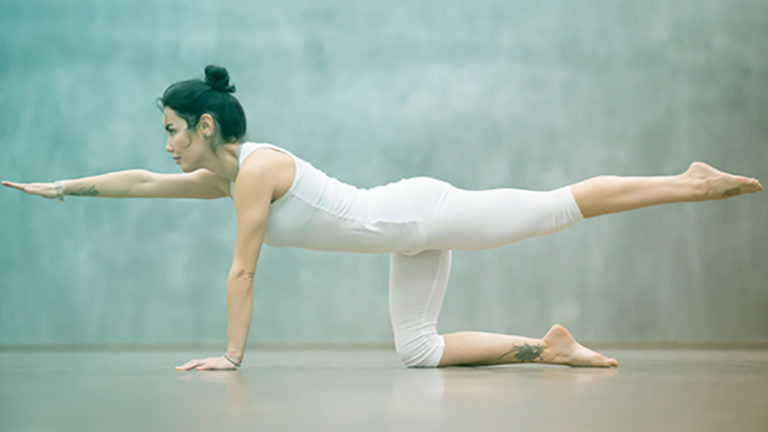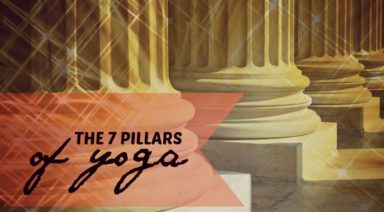The 8 Limbs of Yoga Explained

Yoga is more than the practice of asana, or physical postures. Living yoga means integrating the principles of yoga into your thoughts, words and actions; it means taking yoga beyond your mat. Learn more about living yoga and explore a variety of class option such as Tantrik Meditations, Yogic Paths and Injury, Inquiry and Insight to expand your practice.

The Eight Limbs of Yoga
The Eight Limbs of Yoga are core principles that serve as a compass for living a meaningful and purposeful life.
1. Yamas
Yamas are ethical considerations to help guide interactions with others. There are five yamas:
- Nonviolence (Ahimsa)
- Truthfulness (Satya)
- Non-stealing (Asteya)
- Chastity and fidelity (Brahmacharya)
- Non-coveting (Aparigraha)
At first glance, these considerations mirror the basic morals taught in kindergarten, but have depth in their continued practice. Here are a few alternative versions to consider:
- Ahimsa: practice nonviolence in thought, word and deed; practice self-love
- Satya: tell the truth; opt for silence if your words may harm others
- Asteya: do not steal, even in non-material ways, such as withholding information or time
- Brahmacharya: use your energy wisely and with intention; avoid excess or overindulgence
- Aparigraha: you are enough and you have everything you need already
Please keep in mind that there are many interpretations of the Yamas and Niyamas; find the definitions best suited to your personal practice.
2. Niyamas
The Niyamas are practices that inform self-discipline and worldview. The maxims below generally reflect the essence of each Niyama:
- Saucha: “Leave a place cleaner than you found it” (cleanliness)
- Santosha: “Don’t worry, be happy” (contentment)
- Tapas: “When the going gets tough, the tough gets going” (willpower and self-discipline)
- Svadhyaya: “Learn from your mistakes” (study of self and sacred scriptures)
- Ishvara Pranidhana: “Have faith” (surrender to the divine)
3. Asana
Asana refers to the physical postures practiced in yoga. Derived from the root word as in Sanskrit, which means seat, asana is designed to prepare the body and mind for seated meditation. The term asana refers to the ancient yogic tradition of taking a seat close to your teacher. Beyond the physical, asana refers to an outlook that life is full of opportunities to learn, even through obstacles: find the teacher in all things.
Introduction to Tantrik Yoga
Learn the basics of Tantrik Yoga, such as how to use breath, mantra, mudra and awareness to unlock and unfold the hidden potentials that lie within every human being.
4. Pranayama
Breathing is the only bodily function that you perform consciously and unconsciously; it can be voluntary or involuntary. However, breathing patterns, such as a tendency to hold your breath, are indicators of mind and body health. Pranayama is the practice of consciously controlling the breath, of taking your breath back into your own lungs. In Sanskrit, prana is our vital life force, so pranayama is the cultivation and mindful use of life force. Pranayama leads to improved concentration, health, focus, clarity, creativity, purpose and compassion.
5. Pratyahara
Pratyahara is the practice of withdrawing from external stimuli to enhance internal awareness. Mindfully return to quiet through meditation and removal of distractions. Set aside 5-10 minutes each day to sit or lay quietly with your eyes closed. As your practice grows, your heightened sense of awareness leads to an ability to see things are they are, not as you are. Draw inward, not to silence your senses, but to quiet them enough to see beyond yourself.
6. Dharana
Dharana is the practice of intense concentration, usually focusing on one object, such as the flame of a candle or a picture of a deity. This practice trains the mind in stillness and focus. Start with just a few minutes each day and expand your practice as it serves you. If other thoughts or distractions flicker through your experience, recognize them then let them go.
7. Dhyana
Dhyana is the state of being keenly aware, yet without focus. It is awareness without judgment or attachment; it is peaceful, meditative and precedes complete bliss. It is otherwise known to artists and athletes as the flow state. Consider moments in your life where you were so engrossed in the present that you lost track of time or desire (even for food). The practice of yoga offers a return to this state.
8. Samadhi
Samadhi is a state of ecstasy. It is transcendence, connectivity with the divine, a coupling with the universe, and a mind-body integration of the concept that “all things are one.”
Who is Patanjali?
Patanjali, a revered scholar in the yogic tradition, is credited with authoring the Yoga Sutras, a foundational text for classical yoga. In the Yoga Sutras, the eight limbs are referred to as ashtanga, ashta meaning eight and anga meaning limb in Sanskrit. Patanjali is estimated to have lived in India sometime between the 5th century BCE to 4th century CE.
The Science of Suffering: Understanding the 5 Kleshas and What They Really Mean

For most of us, life is pretty simple when we’re born. Our needs are met. Our concerns are only essential. Our world is new, beautiful, and engaging. And, most importantly, we are connected to the source of the universe, enjoying a direct line to love. In the profound teachings in A Course in Miracles, one of the most foundational beliefs is that when you are connected to this source your life is good, miraculous in fact. But, when separated from it, life is painful and complicated; you are overwhelmed with the feeling of being lost.
In Patanjali’s Yoga Sutras, another equally profound book of wisdom, the concept of being separated from the universal source of love is broken down into five identifiable roots of suffering. Known as the kleshas, these roots are what keep us away from love and, therefore, are what cause us to suffer.
By understanding the science of suffering by digging into these kleshas, you can begin to become aware of what is keeping you from enjoying life, what is keeping you from knowing, as the yogis say, your true nature.







































